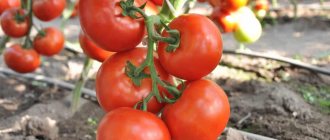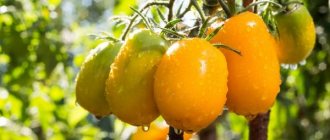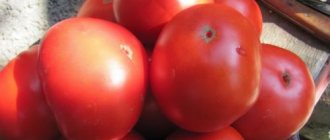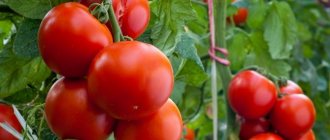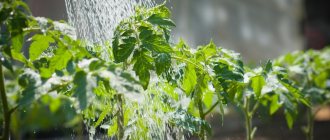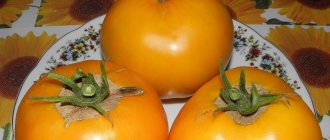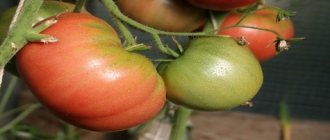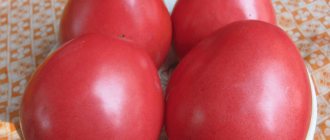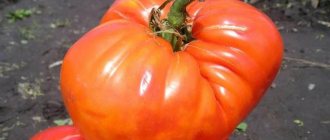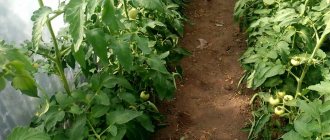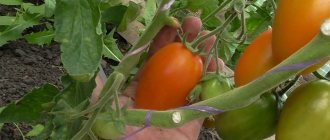There are many varieties of tomatoes, varying in taste, size, shape and color. Amana Orange is considered one of the brightest, decorating gardeners’ beds with dignity. The variety was bred in 1984 by American amateur breeder Gary Staley. And tomatoes got their name in honor of the German colony-settlement of Amana, where a collector of unusual varieties worked at that time. Amana Orange conquered gardeners with its fruit size, excellent taste and bright colors. The popularity of Amana Orange tomatoes is confirmed by numerous positive reviews.
Description of the tomato variety Amana Orange
The Amana Orange agro tomato is a mid-early variety. The period from the appearance of the first shoots to the onset of technical ripeness of the fruit is 100-110 days, from the moment of planting the seedlings in the ground - 40-45 days. The variety is indeterminate (tall). The height of the bushes reaches 1.5-2 m.
Amana Orange tomato inflorescences are of intermediate type, internodes are of medium length. The first peduncle appears above the 9th leaf, all subsequent ones every 3 leaves. One cluster can bear up to 5-6 fruits. Tomato leaves are of regular shape, large, dark green in color. The surface of the foliage is matte, slightly wrinkled.
Amana Orange is a large-fruited, fleshy variety that belongs to the category of beef tomatoes. The average fruit weight is 300-600 g. With proper adjustment of the load on the bush, the weight of tomatoes can reach 800-1000 g. The shape of the fruit is flat-round, strongly ribbed.
The color of unripe tomatoes is light green, there is no dark spot at the tail. At the stage of full technical ripeness, the fruits acquire a rich, bright orange color with an original honey tint. Amana Orange tomatoes are thin-skinned, with a smooth, shiny surface. There are many seed chambers, but they contain a small amount of seeds. They are located mainly along the edge of the fruit.
Landing
Seedlings that are two months old are considered suitable for planting. Of course, the timing will vary depending on weather conditions in a particular area. The site must be prepared in advance, in particular, dug up and fertilized. The beds are usually placed in the most illuminated area of the greenhouse. It is necessary that the distance between planting holes in a row be at least 40 cm. Three to four seedlings should be planted per 1 m².
It is worth noting that it is customary to plant seedlings that are too elongated by placing them in the planting hole as deep as possible or at a significant slope.
It is not recommended to plant Amana Orange in beds where crops such as:
- potato,
- parsley,
- dill.
Growing seedlings
Many people ask: “When should I plant seeds for seedlings?” This will directly depend on the cultivation conditions. When growing in a greenhouse, sowing should be done in the last week of February. During cultivation in open ground, sowing must be done in mid-March.
When organizing a comfortable temperature, the seed material of the variety does not need additional stimulation before sowing. However, it is advisable to weed out unsuitable seed material. It should be noted that only the largest samples need to be sown.
Sowing of seed material is carried out in peat pots, glasses or specially prepared containers. As soon as the first pair of leaves appears, the young plant should be replanted, this is necessary for faster root growth. In addition, thanks to the Amana transplant, Orange better tolerates the “moving” to a permanent place.
Landing in the ground
Seedlings two months old are considered suitable for planting in the ground. As the plant grows, it will need support, and both the stem and the fruit clusters need support, since under the load of ripening fruit the clusters can break at the point of attachment to the stem. To grow indoors, it will be necessary to carefully observe the irrigation regime.
Taste qualities of Amana Orange tomatoes
Amana Orange is a salad variety with a delicate consistency, sweet taste and delicate aroma. There is a slight astringency in the fruits, which gives it a peculiar piquancy. The pulp of tomatoes is fleshy, tender, juicy. When cut, it is sugary and does not flow with juice. The aroma is pleasant, pronounced, with light fruity notes. Amana Orange tomatoes are suitable for fresh consumption, for preparing canned food, tomato sauces, pastes and juices.
Attention! The pulp of Amana Orange tomatoes contains a special carotenoid pigment - lycopene, which gives the fruit its orange color. According to scientific research, this substance helps reduce the risks of cardiovascular diseases and cancer.
Features of agricultural technology
Tomato seedlings are planted in February. For this reason, additional lighting is necessary. They are sent to the greenhouse 60 days after germination. To achieve maximum results, frequent fertilizing with special fertilizers for tomatoes is required (about once every 2 weeks).
It is necessary to form 1-2 stems; pinching must be carried out on time! We described exactly how to plant tomato bushes in this article. The bushes need a garter to a support or trellis. The first cluster of inflorescences appears under the 9th leaf, and then every 3 leaves. You can harvest tomatoes 40-45 days after planting the seedlings.
Pros and cons of the Amana Orange tomato variety
Based on the description of the variety and reviews from vegetable growers, Amana Orange tomatoes have a number of advantages and some disadvantages.
Advantages of the variety:
- resistance to fruit cracking;
- high taste and commercial qualities;
- bright appearance;
- excellent yield and productivity;
- resistance to the main fungal and viral diseases of tomatoes, in particular late blight.
Disadvantages of Amana Orange tomatoes:
- unsuitable for long-term storage;
- sensitivity to temperature changes;
- bushes need shaping;
- low transportability (fruits are easily wrinkled, which spoils their presentation).
Comment! Amana Orange fruits are not stored fresh; they must be eaten or processed as soon as possible.
Advantages and disadvantages
Amana Orange tomatoes have a number of advantages:
- The main thing is the wonderful taste of the fruit. They are sweet, almost without seeds, very sugary, fleshy.
- They store and transport well and do not crack - which is rare for yellow-fruited varieties.
- Tomatoes are resistant to diseases, especially late blight. Read about other varieties resistant to this disease here.
- It bears fruit even in cold and rainy summers.
There are few disadvantages of the variety, but in fairness we need to talk about them:
- Does not accept cultivation in open ground. In this case, there are few fruits, their taste deteriorates and their sizes are very small.
- They cannot tolerate sudden changes in temperature.
- The first fruits are large, the subsequent ones are much smaller.
Growing
It is recommended to cultivate Amana Orange tomatoes using the seedling method, which involves growing seedlings and then replanting them in the ground. In the process of cultivating tomatoes, the following agrotechnical measures are envisaged:
- regular loosening of the soil;
- weeding;
- watering;
- feeding;
- mulching;
- bush formation;
- pest and disease control.
Growing seedlings
The timing of sowing seeds to obtain seedlings depends on the cultivation conditions. When growing crops in greenhouse conditions, sowing is recommended in the last days of February. When cultivating in open ground, seeds should be sown in March, in the second decade.
When creating comfortable temperature conditions, the seed material of Amana Orange tomatoes does not need additional stimulation before sowing. It is only recommended to discard unsuitable seeds (damaged, small, deformed). The strongest and largest specimens should be sown.
Advice! Before sowing, personally collected seeds must be disinfected and germination stimulated. To do this, it is recommended to soak them in a manganese solution or hydrogen peroxide.
Sowing of seeds is carried out in peat pots, cups or specially prepared containers (containers). The optimal composition of the soil mixture is peat, turf soil and river sand. You can speed up germination by covering the crops with film or glass. After mass emergence of seedlings, the cover is removed.
After the first pair of true leaves appear, the seedlings are planted in order to accelerate the growth of the root system. Also, thanks to picking, seedlings are easier to transplant to a permanent place. It is recommended to harden off the plants before replanting. The procedure is usually carried out 14-21 days before disembarkation. In the first days, the seedlings are taken out into the open air for a short time, which is gradually increased.
Landing rules
Seedlings at the age of 2 months are considered suitable for transplantation. Planting dates will vary depending on the specific climate region. The area for planting seedlings must first be prepared - dug up and fertilized. It is best to place the beds in the most illuminated part of the greenhouse or vegetable garden. The distance between planting holes in a row should be at least 40-50 cm. It is recommended to place 3-4 seedlings per 1 m2.
Advice! Excessively elongated seedlings must be planted by placing them in the hole as deep as possible or at a large angle.
You should not plant seedlings in those beds where the predecessors were potatoes, cauliflower, carrots, cauliflower, parsley and dill.
Watering and fertilizing
Watering Amana Orange tomatoes is most necessary during the period of crop formation. It should be carried out with warm, settled water 2-3 times a week, to the depth of the root system. Amana Orange tomatoes are quite responsive to such a procedure as irrigation. It is recommended to carry it out in the evening, after the peak heat has subsided.
Important! Excessive moisture during the harvest period can cause cracking of fruits, as well as the development and spread of fungal diseases.
The Amana Orange tomato variety is demanding on soil composition. Lack of nutrients affects the growth of bushes and fruit set. It is necessary to start feeding tomato bushes no earlier than 2 weeks after planting in the ground. During this time, the seedlings will have time to adapt to the changed growing conditions. Amana Orange tomatoes can be fed with both mineral and organic fertilizers. It is recommended to completely stop all fertilizing 14 days before the start of harvest.
Pinching and tying
Amana Orange needs to be tied to a trellis or support. It is necessary to tie up both the stem and the fruit clusters during the growth process to prevent them from breaking off under the weight of the filling fruits. It is also necessary to carry out pinching regularly and in a timely manner.
Formation
The Amana tomato variety needs formation, on which the amount of the future harvest depends. It is recommended to grow bushes with 1-2 stems. This method is considered the most effective, allowing to obtain the best yield indicators.
Protection from diseases and pests
Despite the high resistance of Amana Orange tomatoes to diseases, in particular late blight, the bushes require preventive treatments with fungicides. It is recommended to use insecticides to control pests.
Rules for planting and care
The manufacturer in the description of the variety indicates that the Amana Orange tomato should be grown only through seedlings with subsequent planting in the ground. In this case, the seed material is already completely prepared for planting and does not need additional stimulation.
Sowing seeds for seedlings
The timing of sowing seeds can be determined based on growing conditions and local climate. For greenhouse planting, Amana Orange tomato seeds are sown at the end of February, and for open ground - at the beginning or mid-March.
To germinate tomato seeds, you need to create suitable conditions. The soil should be loose and moisture-absorbing, with a rich composition so that the sprouts have enough nutrients. Seedlings are grown in containers and then planted into separate containers. Comfortable temperature for germination is +20… +22°С. After germination, it is reduced to +18°C so that the sprouts do not stretch.
Landing algorithm:
- Disinfect seedling cassettes and fill with moist soil.
- Form furrows for seeds, the depth of which is up to 2 cm.
- Distribute the planting material at a distance of 2-2.5 cm from each other and cover with a 1 cm layer of soil.
- Cover the cassettes with film and place them in a bright place.
With the emergence of seedlings, the film is removed and the seedlings are watered. They pick it up at the stage of 2 true leaves. You shouldn’t delay this, as tall Amana Orange tomatoes quickly stretch out. Picking inhibits leaf growth and stimulates the development of the root system.
Warning! Small, broken seeds are not sown.
As the seedlings develop, they are fed with complex mineral fertilizer for seedlings. Dilute the working solution 2 times weaker so as not to burn the thin roots. The first time feeding tomatoes is done 14 days after picking. Then again 7 days before transplanting into the greenhouse.
Transplanting seedlings
Amana Orange seedlings are transferred to a permanent place in the greenhouse as soon as 6-8 true leaves have formed. The specific timing in each region will be different, it all depends on the climatic conditions and the premises. 2-3 weeks before the planned transplantation, the seedlings are hardened off so that they can more easily adapt to the environment.
The bed for planting the Amana Orange tomato is prepared in advance. The soil is dug up and fertilizing is applied. Particular attention is paid to predecessor crops. Do not plant the variety after cabbage, cucumbers, potatoes, parsley or carrots. Productivity will decrease and plants will become sick.
Tomatoes are planted sparsely so that the bushes are well ventilated and are easy to care for and shape. The wells are prepared at a distance of at least 40-50 cm from each other.
Advice! If the seedlings are very elongated, then they need to be buried or planted obliquely.
Tomato care
For full fruiting, Amana Orange tomatoes require proper care, which begins as soon as the plants take root in the garden. Success can be judged by the new leaves.
A very important point is watering the bushes. It is carried out in the evening or early in the morning, but only with warm, settled water. The soil under tomatoes should always remain moist and loose, but the most frequent watering is required during the period of crop formation. However, there is no need to over-moisten the soil, otherwise the fruits will crack. It is enough to water the garden bed generously 2-3 times a week to wet the soil to the full depth of the roots.
After watering, the soil in the greenhouse must be loosened so that it conducts air well to the roots. To get rid of this exhausting procedure, the bed can be covered with mulch. It can be organic or special fiber.
Proper feeding will help you grow Amana Orange tomatoes and get the expected yield. They begin 10-14 days after transplanting into the ground. The variety is very capricious and quickly reacts to a lack of nutrients in the soil. To replenish it, both organic and mineral fertilizers are added. In the first half of summer, it is better to use nitrogen-containing mixtures, but there is no need to be zealous, otherwise the rapid growth of foliage will inhibit fruiting. When the ovary is formed, it is worth switching to fertilizers with phosphorus and potassium. You can feed it several times with a solution of boric acid or humates.
Important! 2 weeks before harvesting, all fertilizing should be stopped.
Particular importance should be given to the formation of Amana Orange tomato bushes. The amount of the future harvest depends on this. It is better to grow Amana Orange tomatoes with one or two stems; all excess shoots are removed, leaving a stump of 1 cm so that they do not grow back. If this is not done, then the abundance of greenery will lead to fruit peas and fungal diseases. As they grow, the stems are directed to supports and the fruit clusters are additionally fixed so that they do not break under the weight of the tomatoes.
Despite good immunity, Amana Orange tomatoes require additional preventive spraying against diseases and pests. Use standard approved drugs, which are diluted in accordance with the instructions.
